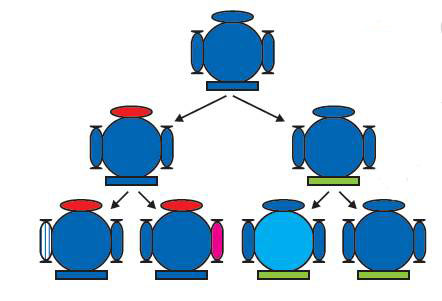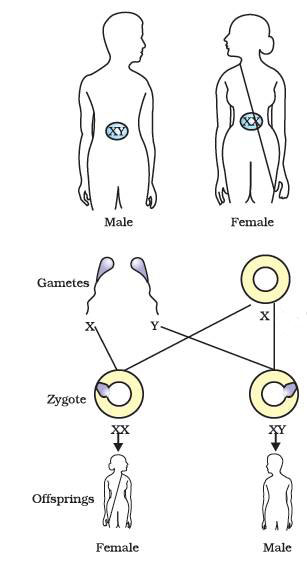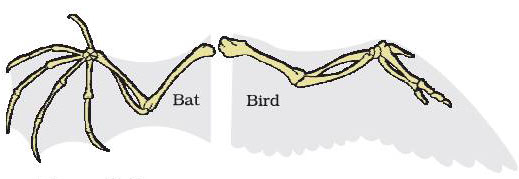The mechanism by which variations are created and inherited. The long-term consequences of the accumulation of variations are also an interesting point to be considered.
Inheritance from the previous generation provides both a common basic body design, and subtle changes in it, for the next generation. The second generation will have differences that they inherit from the first generation, as well as newly created differences

If one bacterium divides, and then the resultant two bacteria divide again, the four individual bacteria generated would be very similar. There would be only very minor differences between them, generated due to small inaccuracies in DNA copying. However, if sexual reproduction is involved, even greater diversity will be generated, as we will see when we discuss the rules of inheritance.
The most obvious outcome of the reproductive process still remains the generation of individuals of similar design. The rules of heredity determine the process by which traits and characteristics are reliably inherited.
A child bears all the basic features of a human being it does not look exactly like its parents, and human populations show a great deal of variation.
The rules for inheritance of such traits in human beings are related to the fact that both the father and the mother contribute practically equal amounts of genetic material to the child. This means that each trait can be influenced by both paternal and maternal DNA. Thus, for each trait there will be two versions in each child.
Cellular DNA is the information source for making proteins in the cell. A section of DNA that provides information for one protein is called the gene for that protein.
Whenever each pea plant must have two sets of all genes, one inherited from each parent. For this mechanism to work, each germ cell must have only one gene set. Each cell will have two copies of each chromosome, one each from the male and female parents. Every germ-cell will take one chromosome from each pair and these may be of either maternal or paternal origin. When two germ cells combine, they will restore the normal number of chromosomes in the progeny, ensuring the stability of the DNA of the species. Such a mechanism of inheritance explains the results of the Mendel experiments, and is used by all sexually reproducing organisms.
When the two sexes participating in sexual reproduction must be somewhat different from each other for a number of reasons.
The genes inherited from our parents decide whether we will be boys or girls. The explanation lies in the fact that all human chromosomes are not paired. Most human chromosomes have a maternal and a paternal copy, and we have 22 such pairs. But one pair, called the sex chromosomes, is odd in not always being a perfect pair. Women have a perfect pair of sex chromosomes, both called X. But men have a mismatched pair in which one is a normal-sized X while the other is a short one called Y. So women are XX, while men are XY.

The sex of the children will be determined by what they inherit from their father. A child who inherits an X chromosome from her father will be a girl, and one who inherits a Y chromosome from him will be a boy.
There is an inbuilt tendency to variation during reproduction, both because of errors in DNA copying, and as a result of sexual reproduction.
The germ cells of sexually reproducing populations are made in specialized reproductive tissue. If the weight of the beetle is reduced because of starvation, that will not change the DNA of the germ cells. Therefore, low weight is not a trait that can be inherited by the progeny of a starving beetle. Therefore, even if some generations of beetles are low in weight because of starvation, that is not an example of evolution, since the change is not inherited over generations. Change in non-reproductive tissues cannot be passed on to the DNA of the germ cells. Therefore the experiences of an individual during its lifetime cannot be passed on to its progeny, and cannot direct evolution.
Micro-evolution means that the changes are small, even though they are significant. Also, they simply change the common characteristics of a particular species. When this happens, they can be called two independent species. In this huge population of beetles, there will be sub-populations in neighbor-hoods.
Since male and female beetles have to meet for reproduction to happen, most reproduction will be within the sub-populations. Of course, an occasional adventurous beetle might go from one site to another.
Over generations, genetic drift will accumulate different changes in each sub-population. Also, natural selection may also operate differently in these different geographic locations. Thus, for example, in the territory of one sub-population, crows are eliminated by eagles. But this does not happen for the other sub-population, where crow numbers are very high. As a result, the green variation will not be selected at the first site, while it will be strongly selected at the second.
Characteristics are details of appearance or behavior; in other words, a particular form or a particular function. That we have four limbs is thus a characteristic. That plants can do photosynthesis is also a characteristic.
The cell is the basic unit of life in all organisms. The characteristics in the next level of classification would be shared by most, but not all organisms. A basic characteristic of cell design that differs among different organisms is whether the cell has a nucleus.
The more characteristics two species will have in common, the more closely they are related. And the more closely they are related, the more recently they will have had a common ancestor. An example will help. A brother and a sister are closely related. They have common ancestors in the first generation before them, namely, their parents.
A homologous characteristic helps to identify an evolutionary relationship between apparently different species.
However, all similarities simply in organ shape are not necessarily because of common ancestry.
It would now be interesting to think about whether bird arms and bat arms should be considered homologous or analogous!

When organisms die, their bodies will decompose and be lost. But every once in a while, the body or at least some parts may be in an environment that does not let it decompose completely. If a dead insect gets caught in hot mud, for example, it will not decompose quickly, and the mud will eventually harden and retain the impression of the body parts of the insect. All such preserved traces of living organisms are called fossils.
If we dig into the earth and start finding fossils, it is reasonable to suppose that the fossils we find closer to the surface are more recent than the fossils we find in deeper layers. The second way of dating fossils is by detecting the ratios of different isotopes of the same element in the fossil material.
A complex organ will be created bit-by-bit over generations. In fact, the eye – like the wing – seems to be a very popular adaptation.
Insects have them, so does an octopus, and so do vertebrates. And the structure of the eye in each of these organisms is different – enough for them to have separate evolutionary origins.
A change that is useful for one property to start with can become useful later for quite a different function.
Both human beings and chimpanzees have a common ancestor a long time ago. That common ancestor is likely to have been neither human or chimpanzee. Also, the first step of separation from that ancestor is unlikely to have resulted in modern chimpanzees and human beings. Instead, the two resultant species have probably evolved in their own separate ways to give rise to the current forms.
In fact, there is no real ‘progress’ in the idea of evolution. Evolution is simply the generation of diversity and the shaping of the diversity by environmental selection. The only progressive trend in evolution seems to be that more and more complex body designs have emerged over time. However, again, it is not as if the older designs are inefficient!
For a long time, people used to talk about human ‘races’. Skin colour used to be the commonest way of identifying these so called races. Some were called yellow, some black, white or brown. A major question debated for a long time was, have these apparent groups evolved differently? Over recent years, the evidence has become very clear. The answer is that there is no biological basis to the notion of human races. All humans are a single species.
